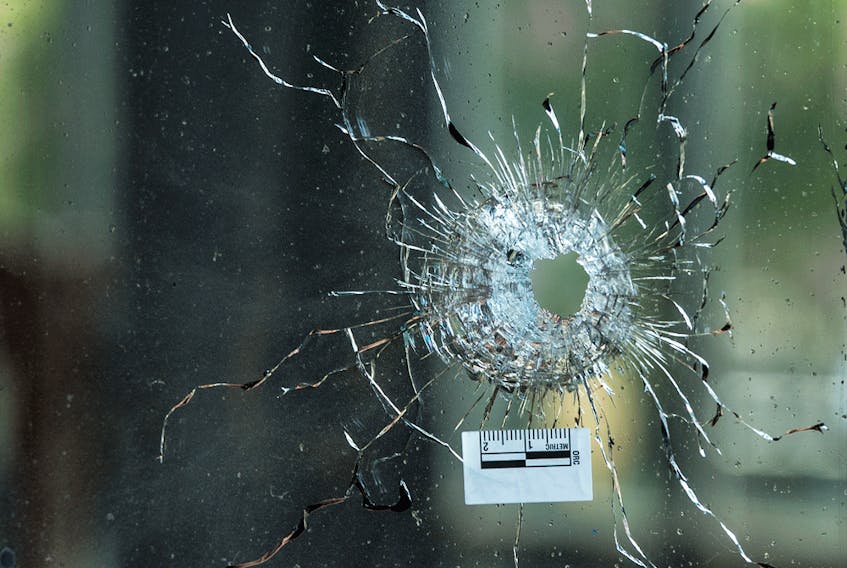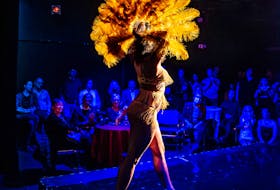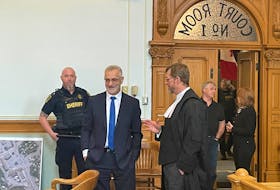On a Sunday night last summer, almost exactly one year ago, a young man, his brain awash in an online swamp of misogyny, conspiracy and hate, walked past Pappas Grill on Danforth Avenue and fired three bullets across the outdoor patio and into the restaurant.
One of the bullets, from a Smith and Wesson M&P .40 handgun, struck a metal umbrella stand. Another hit a waiter, bending over at a lucky moment, in the leg. The third travelled diagonally, across the patio, and through the third pane down on the right hand side of an interior glass door that was propped open against the heat.
The glass, thick and gas infused, didn’t shatter. Instead, the bullet went straight through and into the vestibule wall behind. It left a small, jagged hole in the glass, about a centimetre wide, surrounded by a discreet grid of expanding cracks.
Faisal Hussain shot 16 people that night on the Danforth. He killed three of them — Reese Fallon, 18, 10-year-old Julianna Kozis, and himself — and badly wounded several others. The waiter at Pappas escaped with a deep graze.

Hussain’s rampage was one of the worst mass shootings in Toronto history. It stretched five blocks, lasted 10 minutes and left behind a long trail of wounds, both visible and not.
The shooting changed the physical and social geography of the Danforth. For weeks afterward signs of violence and mourning were inescapable on the street. Broken windows, bouquets and chalk tributes were everywhere.
But as the months passed and the seasons changed, signs of the shooting began to fade. Within days, repairs to windows and doors began. By summer’s end, the official tributes were gone. By winter, the trail of rubbernecking mourners had slowed to a trickle. Anyone walking the street in late spring would have been hard pressed to find much evidence of the killings at all.
In the Alexander the Great Parkette, where the attack began, a large wooden butterfly now hangs from a tree branch. It’s all that’s left of a once massive memorial. There are black hearts on its wings; Fallon’s name, birth and death dates are printed on the body. “Always Remembered,” it says. “Never Forgotten. Loved Beyond Measure.”
But on the actual street, on the strip where Hussain walked and fired, there’s almost nothing to see. The restaurants that closed reopened, months ago. The messages of strength and solidarity, written on windows and walls and sidewalks are long gone. All that’s left is a single broken pane of glass on the inside door at Pappas Grill, a last reminder of what happened here one year ago.
On a recent weekday afternoon, John Klianis, Pappas manager, sat on the side patio next to the restaurant, out of the sun. Klianis’s father, Billy, was an art dealer by trade. He came from Greece to Toronto as a teenager, worked as a busboy then talked a regular into giving him work at his gallery.
The elder Klianis got into the restaurant industry almost by accident. He had lost the lease on his art gallery and was looking for a new space when a group of friends approached him about an investment. His friends were planning to open a restaurant on a corner lot in Greektown. They had the space lined up but were just a little short of the money they needed.
“My dad had no intention of getting into the business,” said John Klianis, dressed that day in a teal golf shirt tucked into blue slacks. His plan was to put his money in, help his friends get off the ground then cash out after a year. That was 30 years ago. One by one the other investors left. Billy Klianis never did. He also never opened another art gallery. Instead, eventually, he became the sole owner of Pappas Grill.

John, now 46, started at Pappas as a busboy when he was 16. Over the years, he bartended, washed dishes, waited tables. “You name it,” he said. He went away for a while, for school, but he always came back. Today, he’s the manager.
On that Sunday night last summer, Klianis was working, as he usually is, in the restaurant. It was a warm, slow night. By 9:50, there was only one family left eating—five people, including two kids, at a round table on the open upper floor.
Klianis was annoyed that night. One of his cooks had slipped out and gone down the back alley to the TD Bank on the corner. “My prep guys, I always tell them, I say, don’t go to the goddamn bank machine at night,” he said. “I just have a bad thing about going to bank machines at night.”
As he was leaving the bank, the cook heard what he thought were gunshots followed by a noise that’s hard to put into words. It’s the sound of collective confusion edging into horror—the realization, by a large group of people, that something bad is happening without all of them yet knowing yet what it is.
The cook ran back to Pappas. “He kind of said to me ‘My god! I think, a gun! A shooting!’ And I said ‘What?’ Klianis looked around for the rest of his staff. There was one waiter out front, chaining up the patio furniture. Everyone else was inside. So Klianis focused on the one occupied table.
He didn’t want to panic the customers but he didn’t want them to leave either, not until he knew for sure what was happening. So he went up to the table and tried to delay them as naturally as he could. “I was like, ‘Hi! I’m the manager here and I just wanted to ask you how your meal was.’” It was late, though, and they had paid and were ready to go. Klianis asked them where they were parked. Across the street, they replied. “And I said ‘You can’t go. You can’t go.”
He told them about the waiter and the possible gunshots. And as he did, they all heard what sounded like more. “It was kind of distinct, like a ‘Pop! Pop!’,” Klianis said. “It was for sure two, it could have been three.” The sound came from down the street. But it wasn’t far away.
In June, the Toronto Police released a report into the shooting. In it, they tracked Hussain’s movement that night, from the time he left home, at 9:10 p.m., until he arrived at the parkette, at 9:56. He shot six people, including Fallon, in the parkette, where a comically small statue of Alexander the Great guards a beautiful and busy fountain. He shot a seventh, a waiter, at Mezes, a Greek restaurant three doors down from the bank.
Hussain kept walking and shooting, on the sidewalk, into the street, walking and shooting, until he came to Pappas. He stopped there, stood in front of the restaurant and fired inside. Klianis didn’t see him then. But he heard the first shot. “POW!,” he said, remembering the sound. He yelled “Run!” and hustled his customers away from the street, out the back door into the alley behind.
From out back, behind the restaurant, Klianis could see into the intersection. He watched Hussain cross the street and carry on west down the Danforth. “I knew it was him,” he said. “There was no else firing the shots. There was only one person waltzing across the street.”

Hussain kept walking. Halfway down the next block, he stopped and fired into Demetres, a speciality ice-cream shop. He struck and killed Kozis there and wounded two others. From there, he crossed the street and shot into a Second Cup, hitting two people and breaking the big glass storefront that faced onto the street. He turned off Danforth at Bowden Avenue, turned down an alley, ran back, fired at 7 Numbers, an Italian restaurant, hit one person, then shot himself in the head.
He died on the sidewalk in front of a church. He was 29 years old.
Soon after the shooting police officers marked the hole in the glass at Pappas with a tiny strip of measuring tape. It showed the halo of cracking glass around the entry wound to be about 2 cm; thin cracks spread out from it like a spider’s legs. That week, Klianis covered over the hole on both sides with white cardboard and clear masking tape. That barrier, and the hole beneath, are still there today.
The days and weeks after the shooting saw a kind of welling up and shrinking back on The Danforth. The police closed the street the next day and makeshift memorials sprung up all around outside the barricades. Messages of hope appeared in sidewalk chalk for hundreds of metres down Logan Avenue, just east of the outer edges of the violence. Teddy bears and flowers were everywhere. Mourners turned the wooden boards blocking off a nearby storefront into a canvass for hashtags and condolences.
By Monday, though, the cleanup had already begun. Professional body movers came first, called by the coroner’s office, to take away the victims and Hussain. Police officers marked and removed bullets and casings on the street and in restaurants. They later unravelled the long loops of yellow tape that blocked off the road, and let the public back in.
The memorials disappeared in stages. It rained that night, and much of the chalk washed away. “But people just picked it up again and started over,” said Jeannette Dowson, who wrote the first message. That cycle continued for days. People would write. It would rain and the messages would fade; eventually, they stopped being replaced. For weeks afterward there were traces and hints still visible. “The chalk doesn’t wash away all at once,” said Dowson. But those, too, soon disappeared.
After the police reopened the street, a massive, impromptu memorial sprung around the Alexander the Great Parkette. The city moved that memorial, two weeks after the shooting, to the nearby Logan Green to make way for the annual Taste of the Danforth Festival. Two weeks after that, one month and one day after the attack, the memorial at Logan Green was taken down, in accordance with city policy.
Most of the items from the memorial, stuffed animals soaked and soaked again in the summer rains, soggy posters, candles melted into wax rumps, were thrown away. The parks department put the wooden boards, covered now with a month’s worth of ink and sentiment, in storage. The cut flowers, mountains of them, were mostly dead or dying. But the city took some of the potted blooms away and planted them in an indoor bed at the East York Civic Centre, a municipal building northeast of the shooting site.
The replanted flowers were all annuals. They bloomed brightly for a season, in a bed of evergreen perennials, then wilted away. No one at the city can remember now what they were.
The city kept two other items from the memorial. Curators went to the site before it was dismantled. From amid the great piles of handmade and store bought tributes they selected two paintings for permanent collection. Those canvasses are kept now, wrapped in paper-thin ethafoam, tied with cotton-twill tape, on shelves at the city’s Collections and Conservation Centre, a warehouse of museum goods and historical artefacts in Liberty Village.
On a recent weekday morning, Alexandra Avdichuk, the supervisor in charge of the centre, unwrapped the two canvasses and placed them on top of a cabinet in a ground floor office at the century-old centre. The idea of collecting this kind of artefact is new. In fact, the city had only ever done it once before Danforth, after a man driving a van hit and killed 10 people on Yonge St. in April 2018.
On the Danforth itself, repairs began almost right away. The owner of the Second Cup replaced his bullet-pocked window on the Tuesday after the shooting. Vito Marinuzzi had to wait for the police to finish in his restaurant, 7 Numbers, before he could get a cleaning crew in. But as soon as he was able, he did. He had them sweep away the damage and set up again to open as soon as he could, too soon, he thinks now, in retrospect. “Our biggest mistake was opening up,” he said. “Your knee-jerk reaction is ‘I don’t want to show this affected us.” But it did.
Eventually, even Demetres, which was boarded up entirely after the shooting, reopened. At that point, there was just Pappas left, with its one covered-over pane.
I walked that stretch of Danforth dozens, probably scores, of times between last summer and this one. Every time I looked at that door pane and wondered. I saw the other signs of the attack disappear and I saw it stay and I thought it must mean something. But when I finally sat down with John Klianis and asked him, he just shrugged. “I don’t know if we’re leaving it there for a reason,” he said. “For me, it’s out of sight, out of mind.”

Pappas is a big restaurant and it’s old and there’s always something that needs to be fixed. The bullet hole in the glass door is on Klianis’s list, but it’s not at the top. “We’re going to take it out eventually,” he said. “But honestly, it’s a real nightmare. They want like $180 just for that piece of glass.”
He doesn’t think about that night when he sees the broken door. He doesn’t think much about that night at all. “I just try not to fixate on it,” he said.
I had been doing the opposite, fixating on that one bullet hole, that one pane of glass, for a year. Stuck in my own head, I’d filled it full of meaning that wasn’t there.
There’s a tendency after large public tragedies to look for meaning, to turn the page, to express strength and hope and push out the idea that what happened isn’t really ‘us’. But the truth of violence is that, in most cases, it doesn’t have any meaning at all.
The police investigated Faisal Hussain for 10 months after the attack. They found no definitive reason for his rampage. He had mental health problems. He was obsessed with violent figures. He had what looked like a growing fascination with misogynist Incels. But none of that let police pinpoint a single reason for his crimes. Hussain didn’t leave a letter, an explanation. It probably would not have mattered if he had.
Murder creates jagged holes, in people and lives and things. They get covered over, but they never really go away. There’s no meaning that can make that any less true.
At the city conservation and collection centre that morning, Avdichuk pointed at the two paintings in turn. They were selected for opposite reasons, she said. The first looks almost professionally done. It shows the gates of heaven in black opening onto a golden beyond and bears the hashtag “DanforthStrong.” The second is a purple canvass with red letters that reads “We Will Miss Our Danforth Friends.” Young children painted and signed it. “It was kids who were sad,” said Avdichuk.
There is no professional guidance, really, on how to remember this kind of thing. There’s no manual for curating a random attack. Two of Avdichuk’s colleagues are trying to build one, though. They’re presenting a paper on the topic — “Preserving Tragedy” — at a museum conference this fall.
It’s just taken as a given that someone, somewhere, will face this same problem soon.
• Email: [email protected] | Twitter: richardwarnica
Copyright Postmedia Network Inc., 2019









